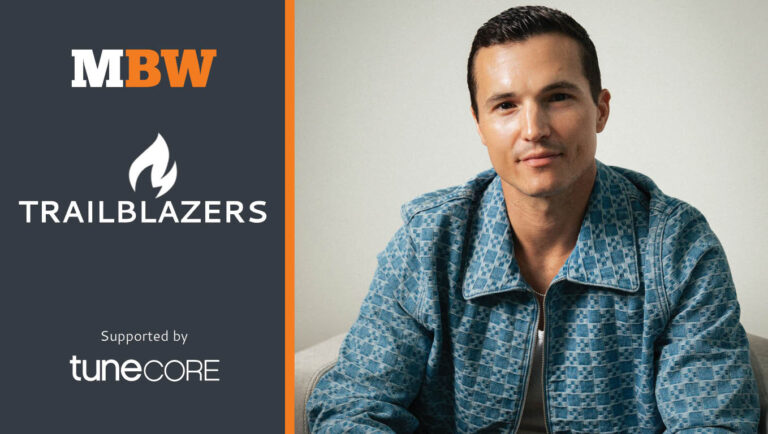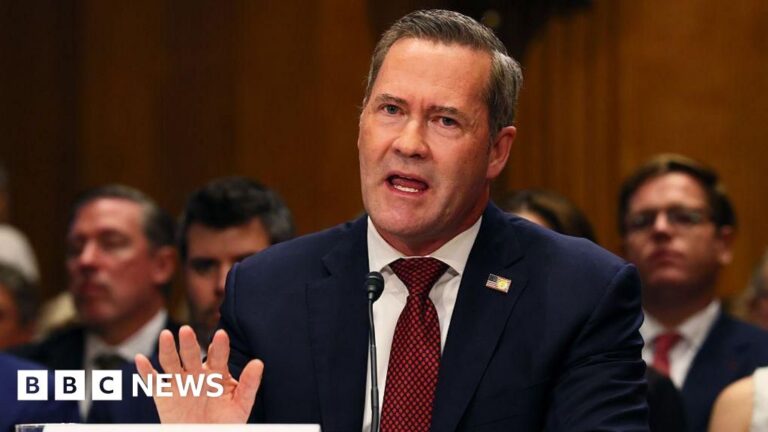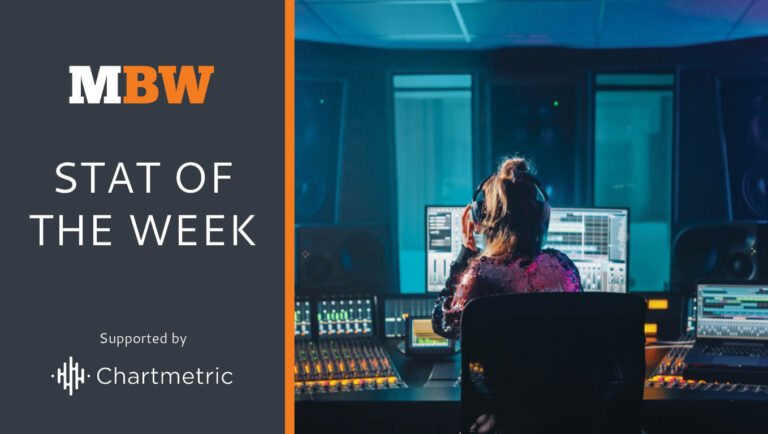Trailblazers is an MBW interview series that turns the spotlight on music entrepreneurs with the potential to become the global business power players of tomorrow. This time, we meet Justin Garza, founder of talent management company, the Dream Adopters. Trailblazers is supported by TuneCore.
Justin Garza didn’t initially set out to become an artist manager, but “the universe” had other plans.
The founder of independent management company The Dream Adopters started his career as a singer and frontman, self-managing his own projects and navigating both the creative and business sides of the industry from day one.
After “hanging up” his own recording artist ambitions, Garza shifted into songwriting for others and became deeply embedded in the “Los Angeles pitch session scene”.
It was there that he says something unexpected happened; other songwriters and producers began approaching him to ask if he’d consider representing them.
“I took it as a sign to listen to what the universe was telling me,” Garza tells MBW, “and I made a conscious decision to pursue management.”
That decision led to an entry-level role at the management company representing The Black Eyed Peas and Will.i.am (Grassroots Music).
Those experiences helped shape his perspective and ultimately inspired the launch of artist, producer, and songwriter management company The Dream Adopters, which he describes as “more than just a management firm”.
Today, The Dream Adopters operates as what Garza calls a “creative-first, globally-minded boutique company” that focuses on artist development, publishing, and music for visual media.
The company has been particularly successful in the K-pop space, with over 120 placements and releases in the genre across the company’s roster.
Recent highlights include The Dream Adopters’ management clients Melanie Fontana and Lindgren writing and producing Takedown for the hit Netflix animated feature K-pop Demon Hunters.
The soundtrack launched at No.1 on the Billboard Soundtrack chart and is currently sitting at No.2 on the Billboard 200.
Looking ahead, Garza has ambitious plans for The Dream Adopters’ global expansion, including building a team of “like-minded managers” in key music markets like Korea, Japan, the United Kingdom, and Germany.
“Long-term, I want The Dream Adopters to be synonymous with innovation and creative integrity,” he tells MBW. “I want us to be a home for forward-thinking creators who want global reach without sacrificing artistic vision.”
Here, Justin Garza discusses The Dream Adopters’ positioning in the global music business, his company’s success in K-pop, and his predictions for the industry’s future.
How is The Dream Adopters positioned in the music business today?
We’re positioned as a creative-first, globally-minded boutique company. Whether it’s artist development, publishing, or music for visual media, we focus on nurturing talent and creating sustainable careers.
We’re not trying to be everything to everyone — we’re selective, we go deep, and we build real value. Our edge lies in our ability to move fast, stay authentic, and tap into multiple revenue streams across different music markets, especially international ones like K-pop.
What are your long-term ambitions for your company’s positioning in the global music business?
Long-term, I want The Dream Adopters to be synonymous with innovation and creative integrity. I want us to be a home for forward-thinking creators who want global reach without sacrificing artistic vision.
“I want us to be a home for forward-thinking creators who want global reach without sacrificing artistic vision.”
That means continuing to scale in strategic ways — expanding into publishing, tech collaborations, sync licensing, and supporting our roster with the tools they need to reach fans across cultures.
A big part of that vision also includes building a global team of like-minded managers in key music markets like Korea, Japan, the United Kingdom, and Germany. I believe having trusted partners on the ground in those regions will be essential for navigating local nuances and truly supporting artists on an international scale.
How do you identify talent you want to work with and sign?
For me, it’s a mix of instinct, work ethic, and uniqueness. The talent I’m drawn to has a clear creative identity, is relentless in their pursuit, and is open to collaboration. We look for people who aren’t chasing trends, but instead, setting them — or even ignoring them altogether because they’re so focused on their own lane.
“I’m looking for incredible human beings at their core — people who operate with the highest level of integrity, not just in the art they create, but in how they handle their business.”
I’m especially drawn to self-starters who are hungry and willing to pour daily effort into being proactive and forward-thinking. Most of all, I’m looking for incredible human beings at their core — people who operate with the highest level of integrity, not just in the art they create, but in how they handle their business. That kind of character is what builds lasting careers and strong creative partnerships.
Your website notes that you are leveraging your talent pool to create original music for film soundtracks, television, commercials, and video games. How big a part of your business is this currently?
It’s a growing part of our business and one we’re genuinely excited about. Right now, sync represents around 25–30% of our activity, and it’s expanding steadily — not just in volume, but in the depth of creative opportunity we’re seeing.
Most recently, our management clients Melanie Fontana and Lindgren wrote and produced the end title song Takedown for the Netflix animated feature K-pop Demon Hunters. Another one of our clients, Curtis Douglas, served as the theatrical and soundtrack mixing engineer and vocal editor for the film.
The project debuted at No.1 globally on Netflix, the soundtrack launched at No.1 on the Billboard Soundtrack chart, and it’s currently sitting at No.2 on the Billboard 200. It’s a great example of how our team can deliver music that resonates both commercially and culturally.

We also recently contributed to Singing in My Sleep, a feature film written and directed by one of my closest friends, Nick Wilson, which hit select theaters and on-demand on July 11.
Melanie and Lindgren wrote and produced five original songs for the film, Curtis engineered several of the soundtrack tracks, and I had the privilege of serving as the sole music supervisor and sharing executive music production credit alongside Melanie and Lindgren — who also happen to be my best friends and longtime creative partners.
Beyond film, we’re also active in television, gaming, and commercial work — including sonic identity creation for brands. Our team’s versatility allows us to deliver everything from cinematic orchestral cues to immersive gaming soundscapes to branded theme music that truly connects with audiences. Sync and custom music work aren’t just side projects for us — they’re core to our mission of helping talent build sustainable, multi-dimensional careers.
You launched Dream Room Publishing alongside Melanie and Lindgren. Tell us about how this venture came to be launched, and what your ambitions are for the publishing side of the business?
I’ve been representing the songwriting and production careers of Melanie and Lindgren for almost eight years now. Over that time, we’ve developed not just an incredibly close creative bond, but a deep friendship built on trust, loyalty, and shared vision. Launching Dream Room Publishing together felt like the natural next step — a way to take everything we were already doing and formalize it under a banner that truly reflects who we are and what we stand for.
“Dream Room Publishing was born out of a desire to redefine the creative experience for songwriters and producers.”
Dream Room Publishing was born out of a desire to redefine the creative experience for songwriters and producers. It blends the best qualities of a powerhouse major publisher with the personalized, hands-on approach of a boutique company. We built it to be the kind of place we always wished existed — where writers are never just “one of many,” but true partners in a shared journey toward artistic and commercial success.
The heartbeat of the company is our relationship — three best friends who genuinely care about the people we work with and the music we help bring into the world. Our services range from song placement and writer development to catalog management and sync licensing, but at the core, Dream Room is about elevating creative voices and creating a space where people feel seen, supported, and celebrated.
Could you tell us about your success in the K-pop space, what that success has stemmed from, and, additionally, share your insight on the broader opportunities you’re seeing in K-pop globally?
Our success in K-pop comes down to three things: consistency, cultural respect, and collaboration. K-pop is one of the most competitive and fast-moving music ecosystems in the world, and it requires a unique understanding of storytelling, melody, structure, and the ability to work seamlessly across cultures and time zones.
“K-pop is one of the most competitive and fast-moving music ecosystems in the world, and it requires a unique understanding of storytelling, melody, structure, and the ability to work seamlessly across cultures and time zones.”
Across our roster, we’ve had over 120 placements and releases in the K-pop genre — a number we’re incredibly proud of. That includes songs for top-tier acts, deep album cuts, and everything in between. We’ve built strong, long-standing relationships with Korean labels, A&Rs, and creative teams, and we’ve taken the time to truly understand the nuances of the market — both creatively and culturally.
On a global level, K-pop is no longer niche. It’s a dominant force in international pop culture and continues to open doors for Western songwriters and producers in new and exciting ways. The fan engagement is unmatched, and the creative bar is incredibly high — which makes it a rewarding space to be in. As the genre evolves, so do the opportunities: from sync and brand collaborations to catalog value and international touring, K-pop continues to be a global growth engine for the entire music business.
What trends are you seeing in the market that we should know about?
I’m seeing a strong shift toward music being part of broader content ecosystems. Artists aren’t just releasing songs — they’re building worlds. Music now intersects with gaming, fashion, storytelling, social media, and even film and TV in ways that are more integrated than ever. As a result, creators who can think multidimensionally are thriving.
There’s also a major push toward authenticity. Fans want to feel like they’re part of an artist’s real journey — not just responding to a polished marketing rollout. That’s influencing everything from how songs are released to how artists show up online.
“I’m seeing a strong shift toward music being part of broader content ecosystems. Artists aren’t just releasing songs — they’re building worlds. “
AI is obviously top of mind in every corner of the industry. From songwriting tools to vocal cloning and personalized listening, it’s moving fast. But the most impactful uses I’m seeing right now are the ones that support human creativity — not replace it. It’s going to be crucial for creators and companies to find ways to embrace the tech without losing the heart.
On the business side, short-form syncs like TikTok sound design and micro-placements are booming. Fan-driven platforms — from Patreon to Discord — are giving artists new ways to monetize and build community on their own terms. And catalog acquisitions are evolving too, with more focus on younger catalogs and hybrid-rights models that combine publishing, master rights, and sync potential.
The biggest through-line across all of this? The artists and companies who are winning are the ones who can be agile, collaborative, and deeply connected to their audience.
What are the biggest challenges facing artist managers today?
The sheer volume of noise. It’s harder than ever to cut through and keep artists focused when everything is happening all at once, all the time. Managers today have to wear multiple hats — strategist, therapist, creative director, and often, firefighter.
One of the biggest challenges is helping artists navigate the pressure to be “on” constantly — to always be posting, promoting, producing, performing. That kind of pace can take a serious toll on mental health and self-worth, especially when social media metrics start to feel like the only measure of success.
“As a manager, you’re not just building careers — you’re helping people manage expectations, stay grounded, and find purpose beyond the algorithm.”
There are also real financial pressures. Even artists who look successful from the outside may be facing inconsistent income, mounting costs, and uncertainty about how to sustain momentum. As a manager, you’re not just building careers — you’re helping people manage expectations, stay grounded, and find purpose beyond the algorithm.
Balancing short-term visibility with long-term career building is key. Viral moments are great, but they can’t be your only plan. The goal is to help artists build something sustainable — creatively, emotionally, and financially.
What advice would you give entrepreneurs starting out in the music business today?
Be relentless and be curious. Don’t chase trends — build relationships, build skills, and build value. Know your numbers, but also know your worth. And remember, this is a long game. The most valuable thing you can do is show up consistently with something real to offer.
Also, operate with integrity. Your reputation will outlive your current title, job, or project — so the way you treat people matters. This business is built on trust and relationships, and those can take years to develop but only moments to lose.
“Team-building isn’t just about delegation — it’s about aligning with people who share your vision and values.”
Surround yourself with people who inspire you, challenge you, and hold you accountable. No one succeeds in this industry alone. Team-building isn’t just about delegation — it’s about aligning with people who share your vision and values.
And finally, stay grounded in why you’re doing this. The music industry can be chaotic and unpredictable, but if your mindset is anchored in purpose and service — to the artist, to the song, to the vision — you’ll find your way through the noise.
What does success look like to you?
Success, to me, is building something that outlasts hype. It’s helping artists and writers create work they’re proud of and sustain careers they control. It’s also about creative freedom — the ability to choose who I work with, what I work on, and how we bring that work into the world.
It’s deeply personal, too. I get to build alongside people I love and trust — and that’s not something I take for granted. Being able to create a business that reflects my values while still showing up for my family, my wife, and my closest friends — that’s a version of success I hold close.
Ultimately, I think about legacy. Not in terms of accolades, but in terms of impact. Did I help people feel seen? Did I create space for others to thrive? Did I use whatever platform I’ve built to open doors for others? If the answer to those questions is yes, then I’m on the right path.
If there was one thing you could change about the music business, what would it be and why?
Transparency. There are still too many layers of confusion and opacity around rights, royalties, and deal structures. Artists and writers deserve to understand exactly what they’re signing and what they’re earning — in plain language, without needing a legal degree or insider access.
“A more transparent and equitable industry isn’t just ethically right — it’s creatively better.”
But it’s not just about visibility — it’s also about fairness. There’s still a major gap in access to information, resources, and opportunities, especially for emerging creatives and underrepresented communities. Too often, the people doing the most vital creative work are the least protected or empowered.
The solution starts with education — making sure creators have the knowledge and tools to advocate for themselves. But it also includes reimagining the models: more equitable contracts, better use of technology to track rights and royalties, and a shift in mindset toward true partnership, not just ownership.
A more transparent and equitable industry isn’t just ethically right — it’s creatively better. When artists feel empowered and informed, they create their best work. And that lifts the entire ecosystem.

Trailblazers is supported by TuneCore. TuneCore provides self-releasing artists with technology and services across distribution, publishing administration, and a range of promotional services. TuneCore is part of Believe.Music Business Worldwide
















